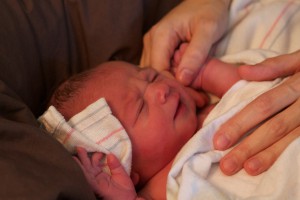I’m pretty sure it never occurred to me I’d ever give birth at home. The first time around, I headed straight to the hospital, hooked up to the epidural, pushed her out and breathed a sigh of relief.
After researching homebirth extensively while co-writing my book, my perspective on birthing began to shift. Birthing was not a medical event in most situations, I realized. It was a life cycle event that belonged to the realm of the family, and it could be meaningful and loving and powerful.
Eight days ago, I gave birth to my second child at home in my bedroom. My three-year-old was watching raptly, making me laugh, bringing me presents and playing with the midwife’s birthing stool. My husband and two midwives rounded out my team of supporters, helping me to move through resistance and bring a beautiful new soul into the world.
When my midwives came by the day after the birth to check on us, one remarked that my labor was a million births in one. What did she mean by that, I asked, having only been present at two myself. It had its boring parts, she said, like when she showed up and I was laboring in the tub. It had its intense parts, like when we were all shouting “yes!” in unison as I was pushing the baby out. It had its restful parts, like when I fell asleep between contractions during transition. It had its calm parts and its fearful parts and its dramatic parts–like when the baby’s head was out and he began kicking his body visibly inside me, trying to work his way out, something my midwife had never seen in her 35 years of practice. It had its funny parts, like when I initiated a round of laughter yoga and my midwife joined in. It had its romantic parts, like when I asked my husband to kiss me as I pushed the baby out.
For me, though, the birth came down to a tremendous physical and psychological challenge–overcoming my fear of the intense sensations I was feeling and finding my way through them using tools that shifted with each contraction. One contraction could be mitigated through rhythmic breathing, another through back massage, another through hugging my husband tightly. I was afraid, not of what could happen to me, but of what was happening to me, of why I was unable to mitigate the sensation through relaxation as I have been able to in yoga. My midwife wisely explained to me that my goal wasn’t to relax my uterus, which actually needed to be clenching and tightening in order to push that baby out.
When I finally pushed and then pulled my baby out and held him on my chest, I felt a huge sense of relief, as if I’d conquered a physical challenge akin to a marathon or massive mountain climb. I felt humbled by the experience yet elated by the magnitude of what I’d achieved.
Everything about birthing in my home environment was perfect: being available to my 3-year-old, even nursing her back to sleep while I was in active labor; having free range of my house, including bed and bathtub; having access to my clothing, blankets, pillows and food; being surrounded by skilled caretakers who followed my lead and contributed helpful suggestions when needed; and not needing to go anywhere when it was over.
My birth experience was challenging, it was exhilarating, and it was memorable. I’m glad that I had the courage to stick with it while living a society which has been trained to think of birth as a medical event fraught with danger. I’ve added birthing to my personal list of mothering experiences that I’ve been able to reclaim as my own.




